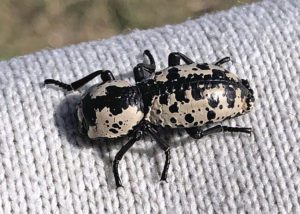Howdy, BugFans,
When BugFan Kine sent this “what is it” picture, the BugLady’s first reaction was to raise her hand and say “Teacher, teacher! Ask me! Ask me!” She didn’t recall its name, but she knew she had seen a picture of it in Kaufman’s Field Guide to Insects of North America (it’s also in the Audubon Society Field Guide to North American Insects and Spiders). It has the look of a darkling beetle (family Tenebrionidae), but it’s in the (fairly closely-related) family Zopheridae (no common name) and the subfamily Zopherinae – the ironclad beetles. Thanks, Kine!
Not a Wisconsin beetle.
Fascinating Ironclad Beetle Fact#1: They’re called Ironclad beetles because they have a phenomenally strong exoskeleton. So strong that you can’t kill them by stepping on them (in the words of Alejandro Santillana of the University of Texas, “Step on one and it will probably just give a coleopteran shrug and walk away.”). So strong that if you are able to kill one, you can’t mount it on an insect pin without first drilling a hole in it.
There are 19 species in the genus Zopherus, and they’re found from Venezuela to Texas, west to California, including Nevada, Utah, and Colorado. Ten species of Zopherus live in North America. Zopherus means “dusky” or “gloomy” in Greek (today’s beetle is the flashiest) – here are a few other species: https://bugguide.net/node/view/919514/bgpage,
Kine’s beetle, the Texas or Southwestern ironclad beetle (Zopherus nodulosus haldemani) also comes in an all-black model (https://bugguide.net/node/view/389911). Its ventral side is fancy (https://bugguide.net/node/view/686104/bgimage), and so is its face (https://bugguide.net/node/view/269544/bgimage). Like other family members, its head is partly sheltered/pulled under the front edge of the thorax, making it look like it’s thinking about a somersault.
One source says that Texas ironclad beetles look as though a random bunch of black paint droplets fell on them (another source suggests that they’re bird-poop mimics). Nodulosus refers to the lumps/nodes on the beetle’s back, especially on the elytra (wing covers), and this species also has four noticeable tubercles on the rear edge of the elytra.
The job of the elytra, which are the hardened, front pair of flying wings, is to protect the membranous flying wings that are folded beneath them, a beetle invention that allows them to crawl under logs and rocks without shredding those delicate wings. But Mother Nature has played a little trick here – beetles in this genus, indeed, in this family, often lack flying wings, and their elytra are fused together. No flying wings = no flying.
They live in east and central Texas, south into northeastern Mexico. Adults are sometimes seen on the trunks of pecan, oak, and elm trees where, despite/because of their coloration, they blend in pretty well. The larvae are found in dead trees and may eat fungi within the rotting wood, but in his blog arrantsoutdoors, Josh Arrants says that “We are sure it eats lichens, dead wood and plant material, even taking fungi…. We also believe that all stages of (Zopherus nodulosus haldemani) eat lichens on dead, or mostly dead, trees.”
There is very little biographical information about this striking, relatively-common-within-its-range, inch-long beetle! Presumably, eggs are laid in bark crevices, which, says Arrants, provides “a highly probable area for the larvae to be able to find and consume lichens.” Here’s a mating pair https://bugguide.net/node/view/1506208/bgimage.
Fascinating Ironclad Beetle Fact#2: In her article about them in the Texas Co-op Power newsletter, Sheryl Smith-Rodgers calls them “Lazarus bugs.” On several occasions, she fished “dead” beetles from the bottom of water buckets, only to have them revive and walk away. They are even hard to kill with the standard-issue insect killing jars.
Fascinating Ironclad Beetle Fact#3: When alarmed, Ironclad beetles play dead (tonic immobility or death feigning or thanatosis are fancier names), and they can play for longer than most people have the patience to wait for their revival. They curl up their legs and tuck in their antennae to protect them https://bugguide.net/node/view/686069/bgimage.
Fascinating Ironclad Beetle Fact#4: With the help of some glue and sparkly stones, some genus members, including this species, are used as live jewelry in parts of Mexico https://en.wikipedia.org/wiki/Zopherus#/media/File:Zopheridae_jewelry_sjh.jpg.
MIND-BLOWING Ironclad Beetle Fact: Science, of course, is interested in this impenetrable insect. The composition of the layers of its exoskeleton have been parsed, and the potential applications are pretty amazing. It is being “copied” in a design for the suspension system of combat vehicles, with the hope that it can bounce back after an IED or other explosion. Even better, First Place in the 2018 NASA competition to design habitats for Mars (the 3D Printed Habitat Challenge) went to Team Zopherus (https://armoneyandpolitics.com/arkansas-architect-nasa-competition-mars/)!
Mother Nature creates, and man imitates.
Kate Redmond, The BugLady
Bug of the Week archives:
http://uwm.edu/field-station/category/bug-of-the-week/

